
The landscape
Naxos has a lot to offer, both for those interested in culture and for nature lovers. The island’s landscape is very varied: there are barren marble slopes with hardly a plant growing on them and green river valleys with lush vegetation; there are high, remote peaks and cultivated plains with a chequered pattern of small reed-lined fields. The island has gentle valleys with olive groves, green terraced vineyards and paradise gardens with vegetables and fruit trees of all kinds; it has steep rugged mountain slopes, in many places bare rock, elsewhere covered with oak forests or low shrub, with hidden springs and deep, densely overgrown ravines. On the coast there are small, secret bays with marvellous white pebbles between steep, forbidding marble cliffs or extensive sandy beaches with juniper-covered dunes.
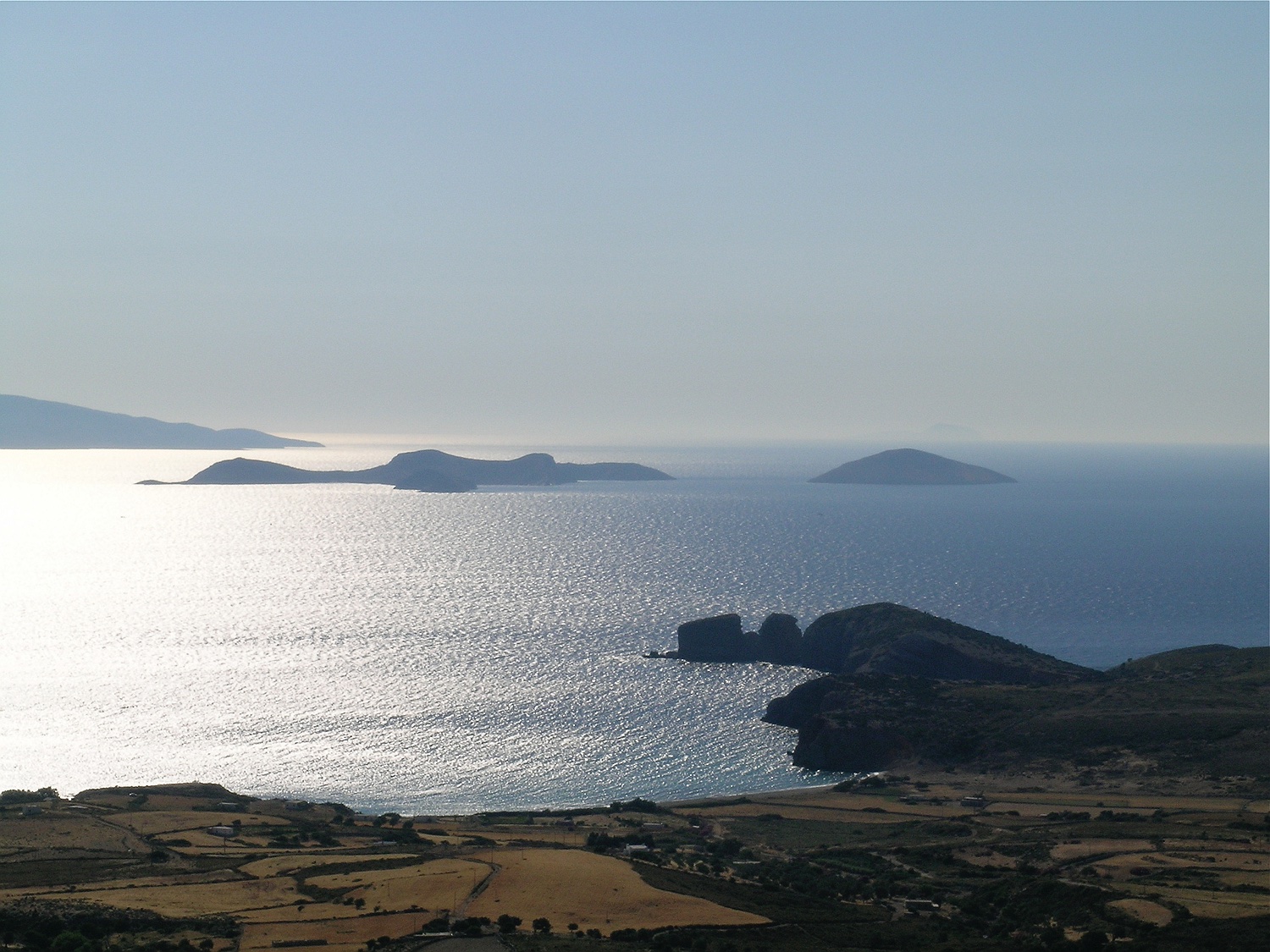
Cape Stavrós and the islands in the morning light
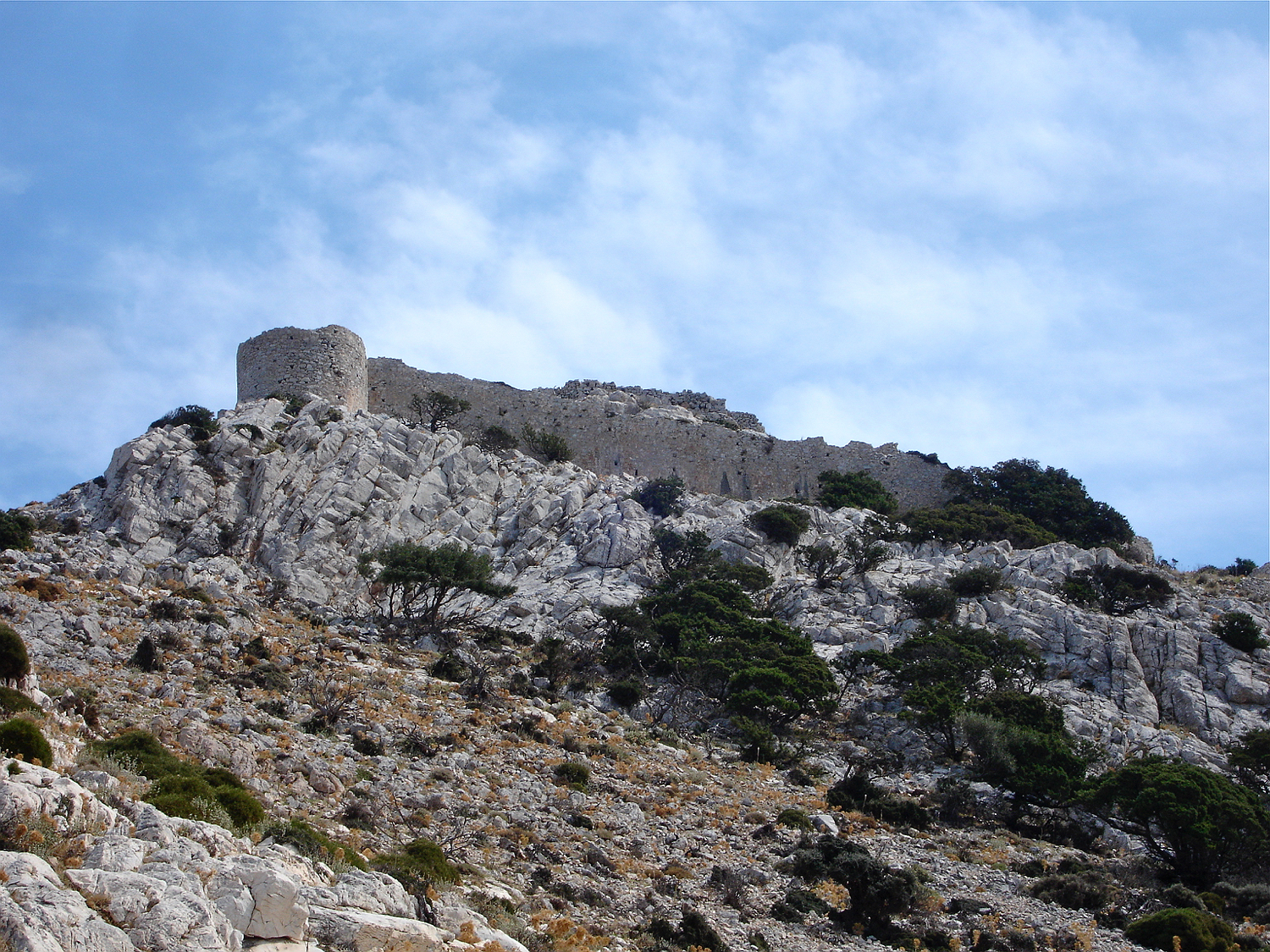
the fortress Kástro Apalírou

the Venetian tower of Agiá

chapel near the Chóra
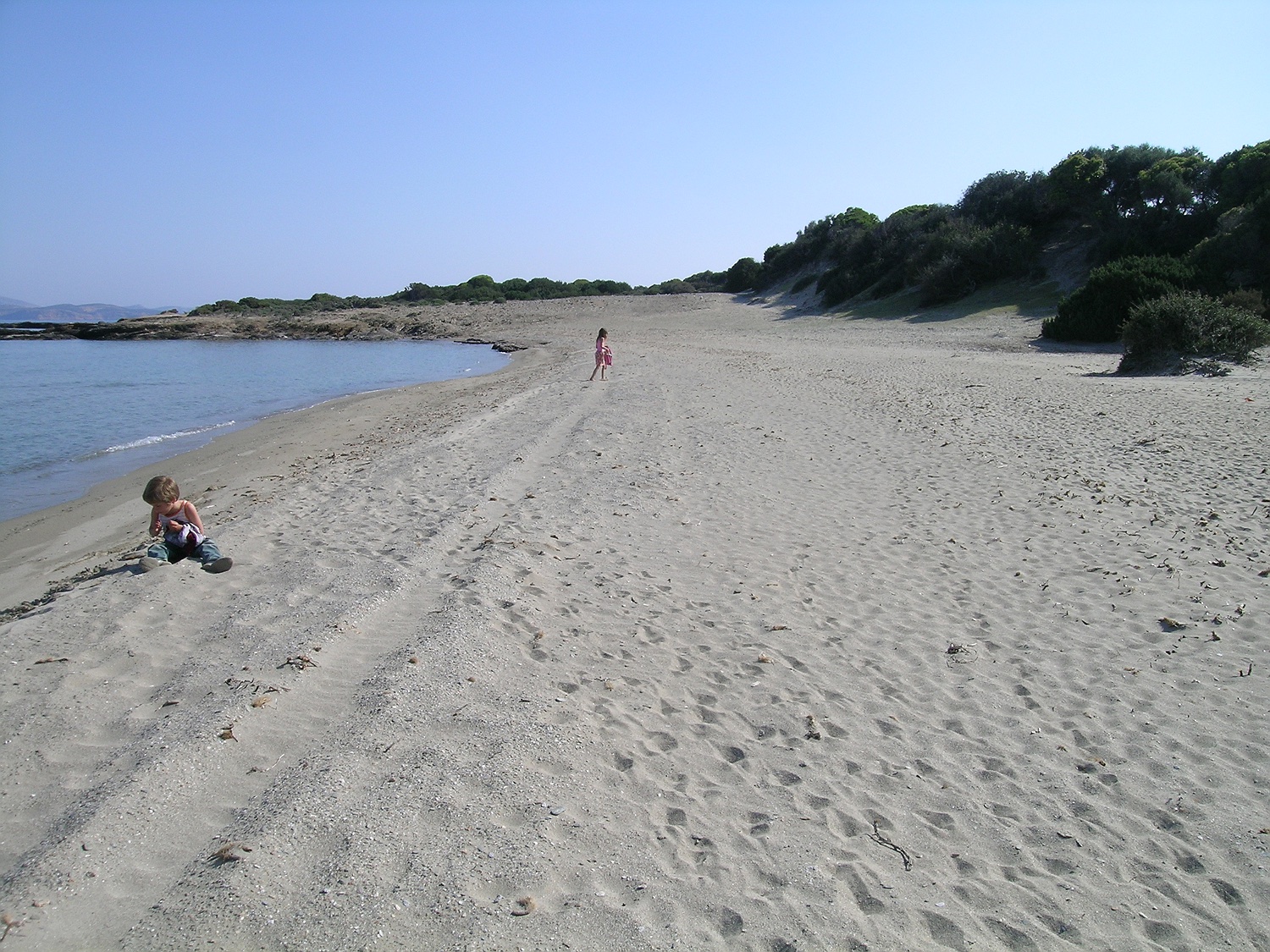
beach in Psilí Ámmos south of Moutsoúna

bay with marble pebbles near Ágios Dimítris
And Naxos has just the right size: The island is small enough to be easily explored on day trips, but large enough to harbour a surprisingly great variety of landscapes – each area of the island has its own character and its own charm.
Mountain and Sea
The close interweaving of the sea and mountainous landscape is typical of Greece: the sea is close by everywhere and often stretches in deep bays into the land, but directly behind the coast in many places high, steep mountains rise. Naxos is also dominated by these two characteristic elements of the Greek landscape: mountain and sea.

the bay of Azalás
The sea can be seen from almost every spot on Naxos; it forms the backdrop everywhere. The island lies right in the centre of the Aegean Sea, roughly equidistant from the Greek mainland, Turkey and Crete. There are few places on earth where so many large and small islands are packed into such a small space as in the Aegean – a unique world whose beauty has been sung about since ancient times. Nevertheless, apart from the coastal strip, Naxos definitely has a mountainous character. The two highest peaks are around a thousand metres high and most of the island consists of a steep mountainous landscape. The peaks look almost alpine, and in the hidden valleys of the mountains you can nearly forget the proximity of the sea.

Mount Zeus, seen from the west
Geology
The diversity of Naxos’ landscape is partly due to the island’s complex geological structure. The strong relief with deep valleys and steep, rocky slopes increases the diversity. The island of Naxos is part of the mountain range that also includes the Alps and the Himalayas. The Aegean is not a real ocean, but a mainland submerged in the sea, with only the mountain peaks reaching above the surface. The steepness of the islands, as that of the mountains of the Greek mainland, is due to the fact that, geologically speaking, it is a young mountain range that has not yet been levelled by erosion.

the main mountain range of the island; looking from Mount Zeus northward
Looking at the geology in a much simplified way, we see that three types of rock occur extensively on the island: marble, slate and granite or gneiss. Each of these rocks forms a distinctly different landscape. Due to their different water retention capacity, susceptibility to erosion and chemical composition, they also provide very different conditions for plants, so that the three types of landscape also differ in vegetation.

marble landscape, to the west of Mount Zeus

granite landscape, around Mount Kóronos

slate landscape, in Myrísi
The Western part of the island
The western part of Naxos is less mountainous than the eastern part. Several plains or more level areas, which were formed in different ways, lie at different heights above the sea. In the vicinity of the capital Chóra lie the so-called Livádia; these are alluvial plains made up of eroded material washed down from the mountains. They are used for agriculture with small fields surrounded by tall reeds that serve as a windbreak. Another characteristic of this landscape are the huge agaves with their metre-high inflorescences. In the middle of the alluvial plain lie the remains of a large temple of Dionysus, the god of fertility and wine.

the Livádia around Chóra
The bedrock in this westernmost part of the island consists largely of granite, which forms beautiful rounded rocky outcrops and weathers into a marvellous coarse-grained sand that forms the extensive beaches of the southwest coast from Ágios Prokópios to Kastráki. In some places, the sand forms dunes covered with junipers.
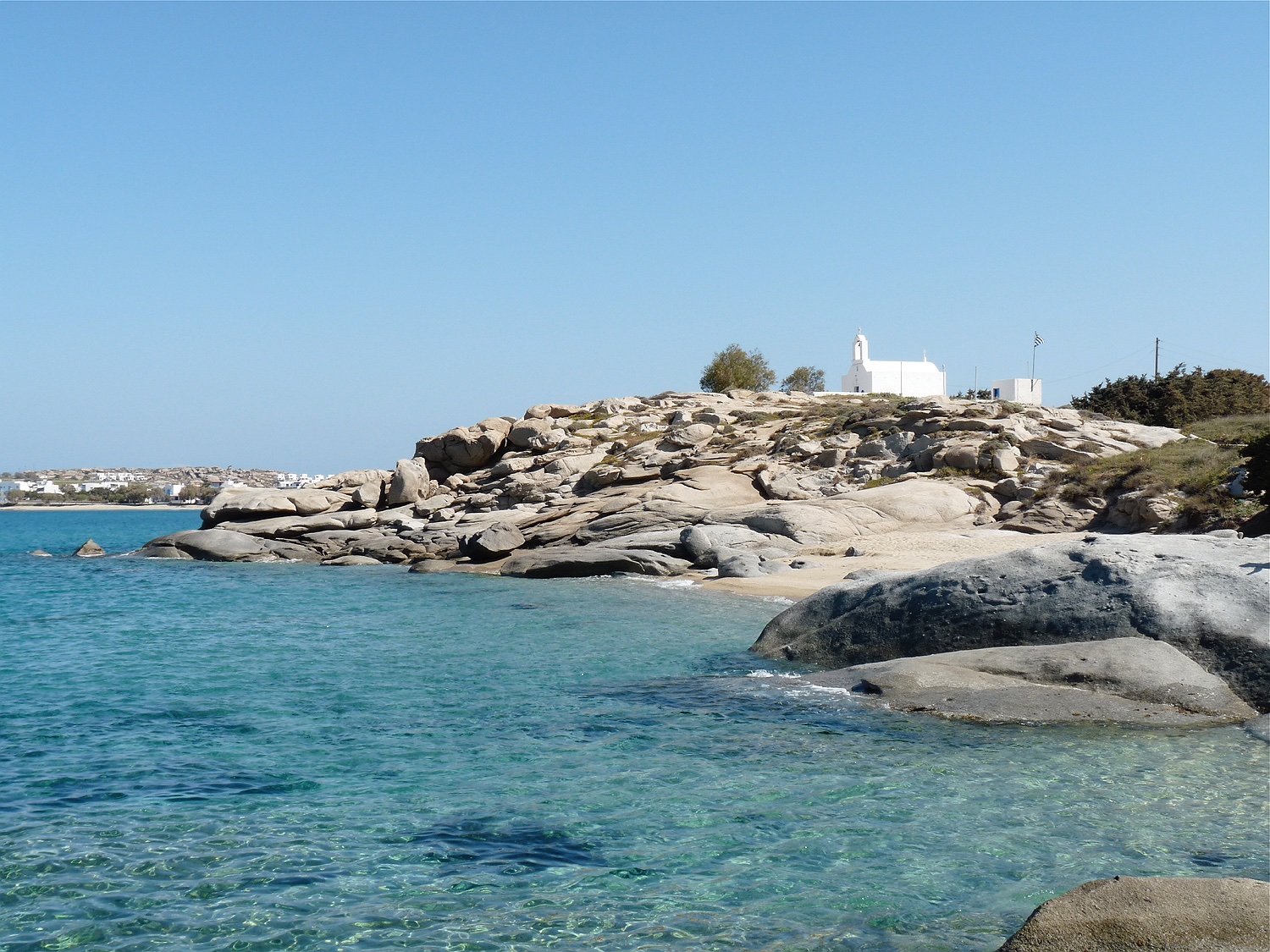
chapel on a granite outcrop at the coast near Ágia Ánna

The granite weathers into a marvellous coarse-grained sand that forms extensive beaches in the Southwest of Naxos.

Juniper on the dunes near Ágia Ánna
The lagoons at the mouths of the rivers, especially the large lagoon at the airport south of Chóra, are of great importance, particularly for migrating waterfowl. Most of the tourism on Naxos takes place in the Chóra and along the sandy beaches south of it near the villages of Ágios Prokópios, Ágia Ánna and Mikrí Vígla.

The lagoon near the airport is filled with water in winter.
In the western part of the island there are some alluvial plains at the mouths of rivers, for example near Engarés to the north of Chóra. This plain, with its many small green fields, mostly planted with fruit and olive trees, gives the impression of an oasis in the middle of the mountain slopes overgrown only with low shrub.

the coastal plain near Engarés
The larger plains further inland were formed in a different way: they were levelled by erosion. The largest plains lie in the neighbourhood of the village of Sangrí. The interesting temple of Demeter, the patron goddess of agriculture, is also located here on a gentle hilltop in the middle of fields that have been cultivated with cereals since time immemorial.

the plains around Sangrí
To the north of Sangrí the green valley of Potamiá, with its tree-lined river and three small, picturesque villages surrounded by gardens and olive groves, is cut into the gently undulating plain.

the valley of Potamiá
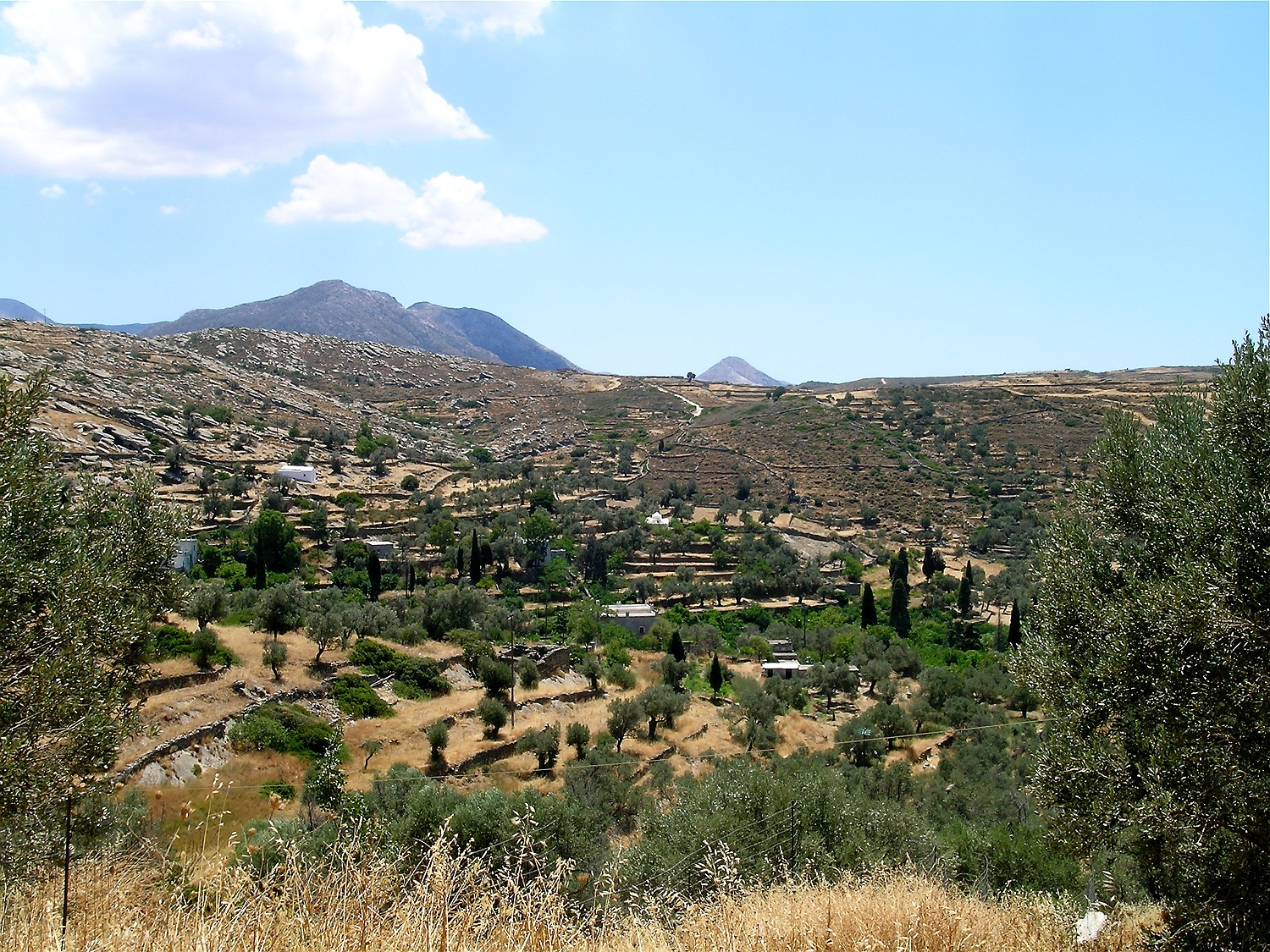
near Potamiá
The centre of the island
The centre of the island is occupied by a nearly level area, the Tragaía, at an altitude of around 300 to 400 metres. This area, overlooked on (almost) all sides by mountains and crossed by several deep gullies, is mostly covered with olive trees, so that from above it looks like a large olive grove. A number of settlements lie in the Tragaía, including Filóti, the largest settlement on Naxos after the Chóra. The Tragaía is the green heart of the island with beautiful villages, numerous interesting churches, Venetian towers and picturesque olive groves, some with ancient trees.

the Tragaía

near Moní

near Kalóxylos
To the west of the Tragaía and east of the valley of Potamiá lies a barren hilly area with a ruined Venetian fortress (Apáno Kástro) enthroned on the highest hilltop. Geologically speaking, this is the uplifted granite core of the mountain. On the barren hills with large rounded granite boulders grows only sparse vegetation, but those who hike here will discover the strange beauty of the granite landscape: the rocks patterned with colourful lichens, orchids many other flowers sprouting between them, and the peculiar weathered granite blocks often hollowed out from below.
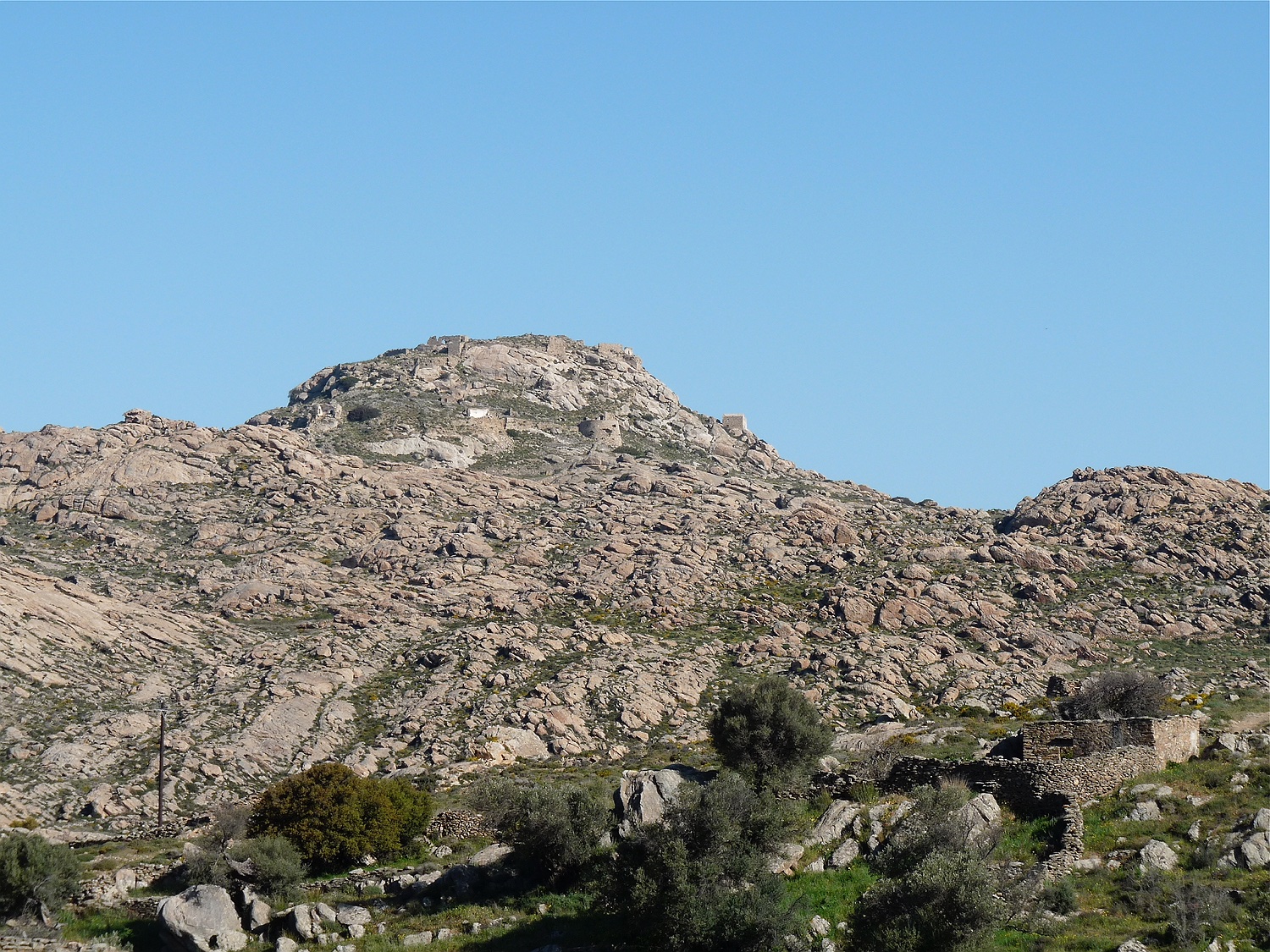
the granite hill with the Venetian fortress Apáno Kástro on its top

The granite boulders erode mostly on their lower surface, forming hollowed-out “Tafoni”
Towards the east, the Tragaía is closed off by the almost 900 metre high ridge of Fanári, while the highest mountain of the island (and the Cyclades), the 1004 metre high Zeus, lies to the south-east.

looking north from the Fanári

Filóti with Mount Zeus in the background
The Eastern mountain ranges consist mainly of marble, occasionally interspersed with layers of slate. They are covered with loose dwarf shrub vegetation, in some places also with remnants of forest, mainly of kermes oak. The peak of Mount Zeus is almost bare. From the summit you can enjoy a breathtaking panoramic view of the island. In the narrow valley of Danakós to the north-east of the summit, with its comparatively moist and cool climate, grows a particularly lush vegetation with many herbs and trees. In the almost vertical, inaccessible western slope of Zeus grows a remarkable small forest of Holm oaks.

Holm oak forest in the western slope of Mount Zeus
The central mountain range and the north of the island
To the north of Tragaía runs the large valley of Kinídaros, where water flows all year round. Along the river grows a dense alluvial forest of alder and plane trees, a rare sight in the Aegean. Here you can immerse yourself in a completely different landscape: the lush jungle-like undergrowth, the gurgling of the water as it gushes over the granite boulders, the shadows of the trees, the pond turtles diving away, the dragonflies playing over the water. Similar rivers also exist in several other valleys to the north-west and north of the Kóronos massif, where the underground consists of granite and slate, which are imprenetable to water so that it flows off on the surface.

the valley near Kinídaros

river at Apóllonas
The peak of Mount Kóronos, which is barely lower than Mount Zeus, is located to the north of the river valley of Kinídaros. Today it is rather barren, although it is said to have been covered in dense chestnut and Holm oak forests until a few centuries ago. Today, the impressive peak is covered with an interesting heather in with many lichens grow due to the frequent cloud cap on this mountain range, formed by the moisture of the air masses rising from the sea with the north wind – even in summer you can get into clouds here. On the western slope of Mount Kóronos near Skepóni grows in a small area a dense maquis with heather and strawberry trees, unique on Naxos.

heather on Mount Kóronos

Erica manipuliflora with lichens of the genus Usnea

near Skepóni to the northwest of Mount Kóronos
In the mountain region, three larger villages (Apíranthos, Kóronos and Komiakí) are located in picturesque open valleys on the flanks of the mountain peaks at an altitude of around 600 metres. The slopes of the valleys are terraced and cultivated with vineyards, fruit trees or vegetable gardens. In the past, every available patch of fertile soil was planted, but today most of the terraces are unused. Around the villages of Apíranthos and Danakós, as well as in the Tragaía, mighty Downy and Vallonean oaks grow, forming impressive, wide-spreading trees.
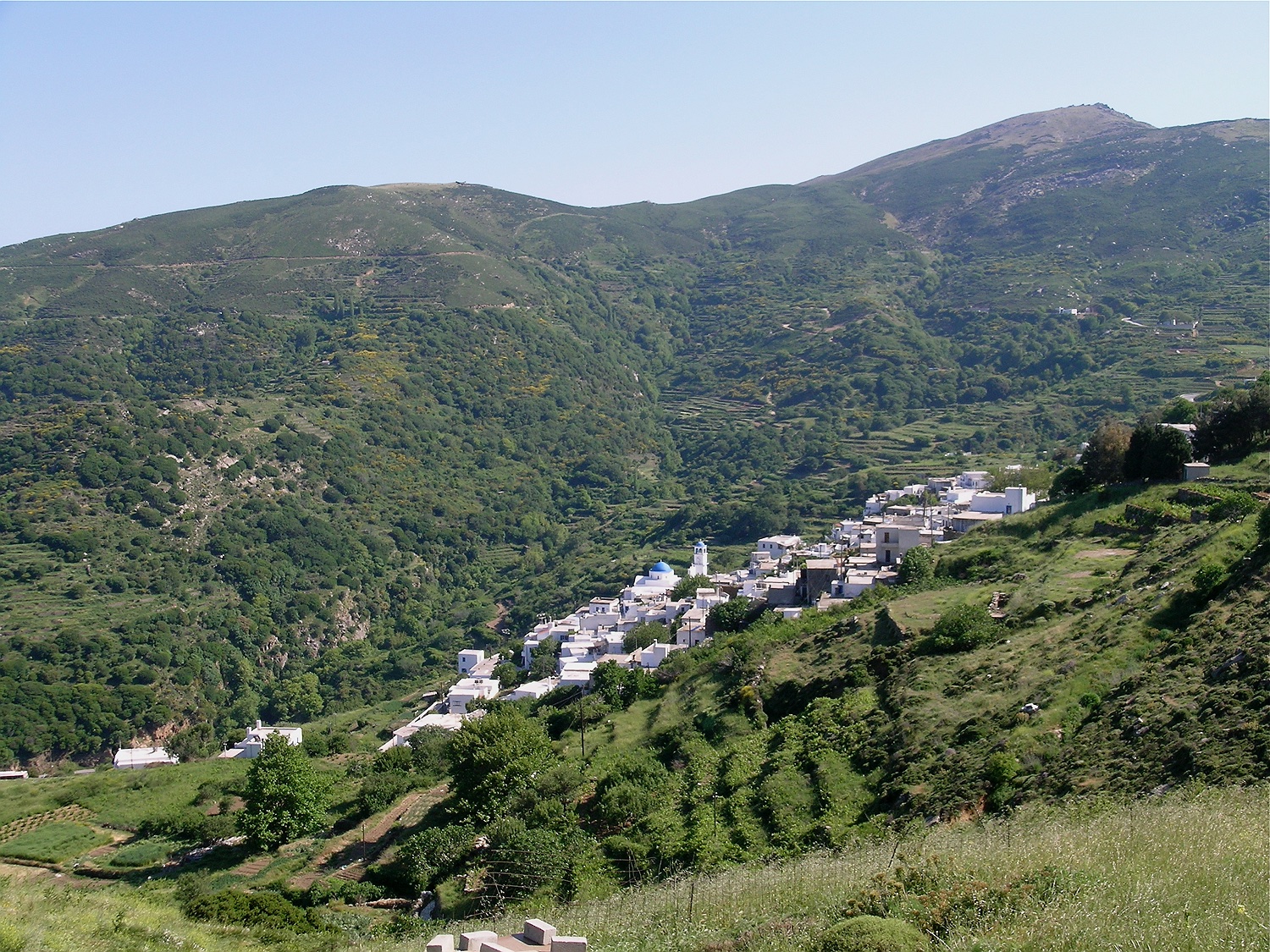
Komiakí

near Apíranthos
The northern part of the island consists mainly of different types of slate. In the lower areas, the steep slopes are covered in dense, monotonous dwarf shrub vegetation, which gives a yellowed, barren impression in summer. In some places grows the tree spurge, of a beautiful yellow-green colour in spring, the turning red at the beginning of summer. The fertile and more humid upper slopes around the village of Komiakí, are in places covered by an almost impenetrable wood of overgrown fruit trees, Cretan maple, bramble and numerous other plant species.
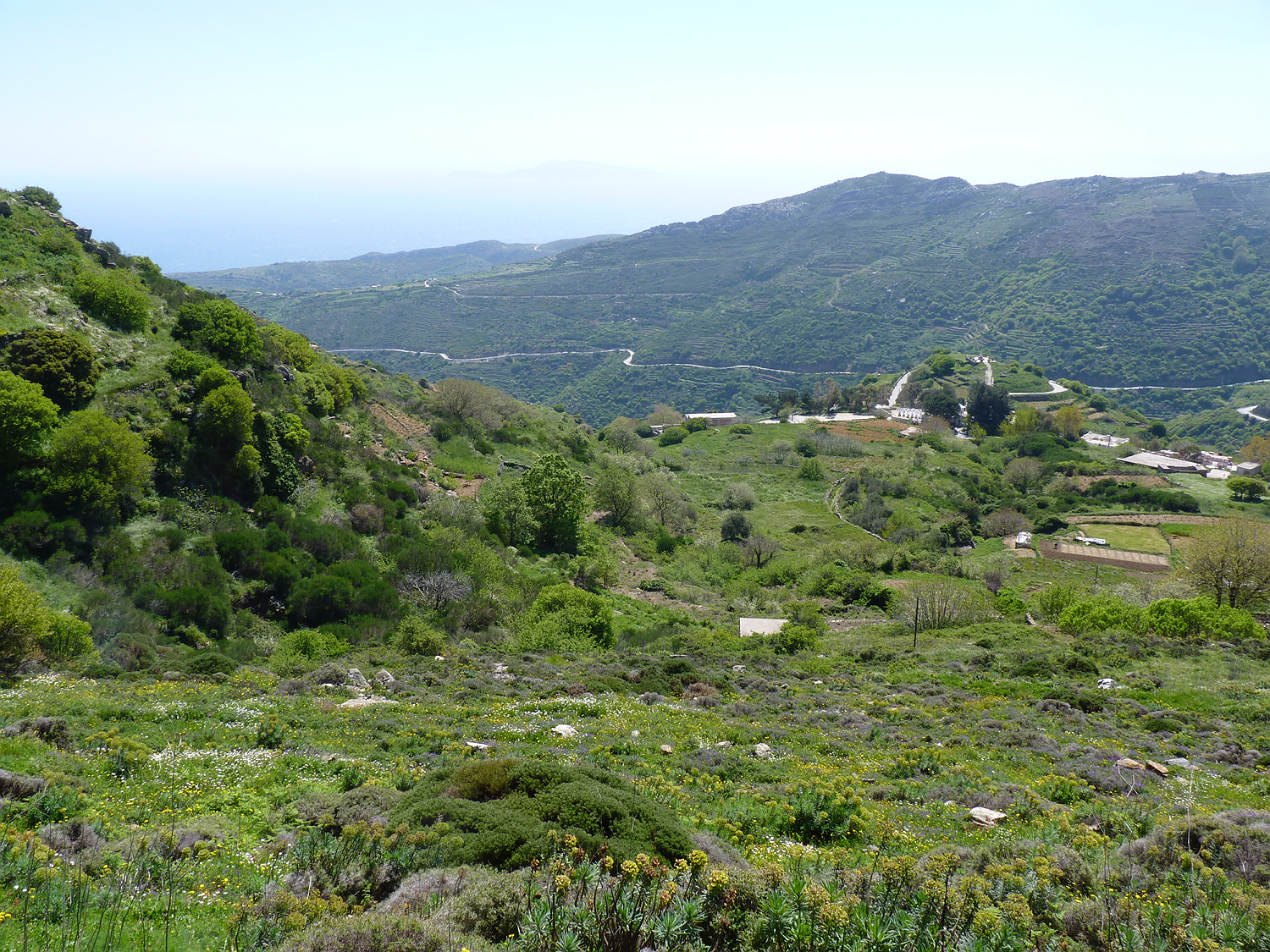
landscape near Komiakí
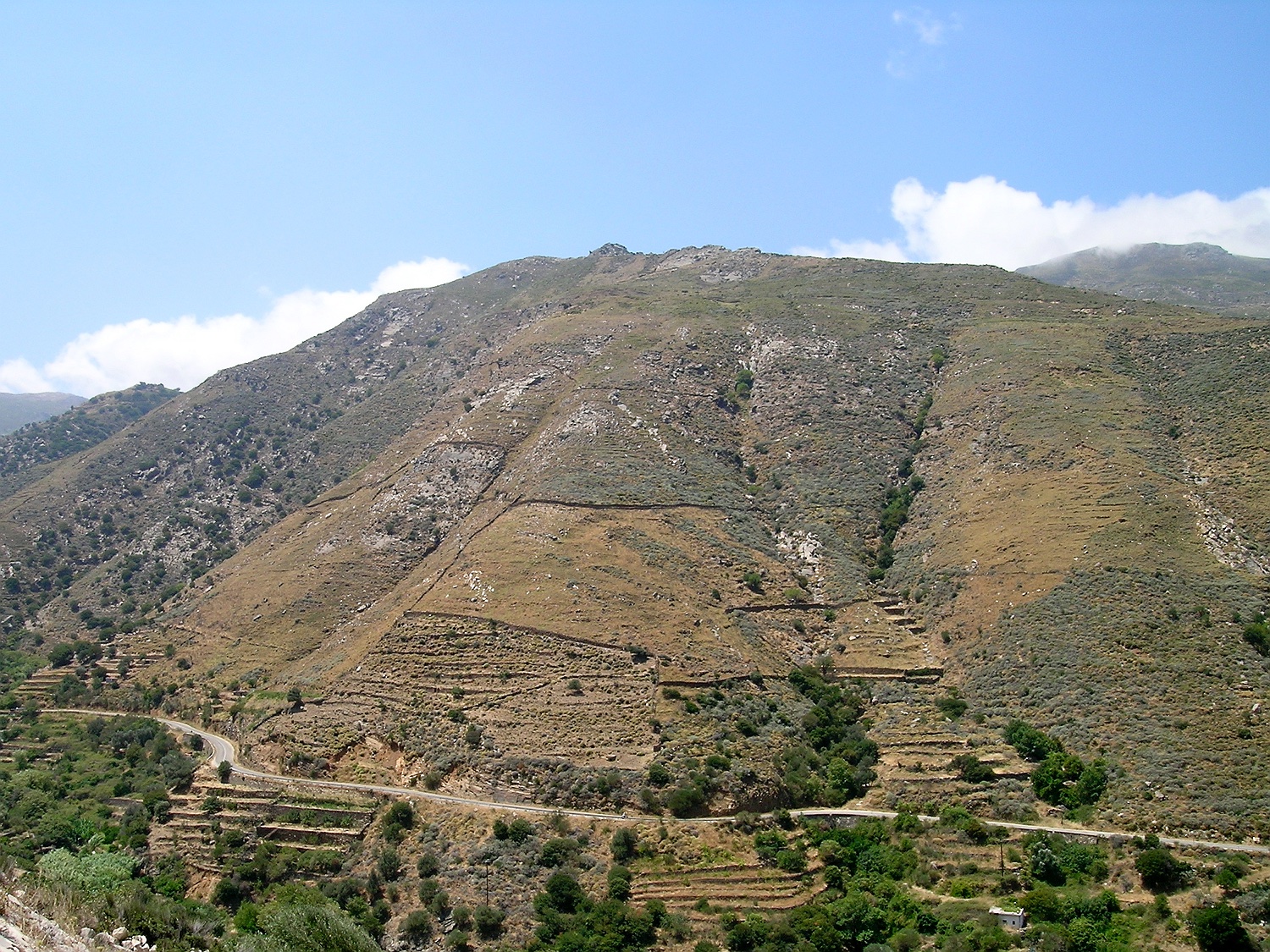
the valley of Apóllonas
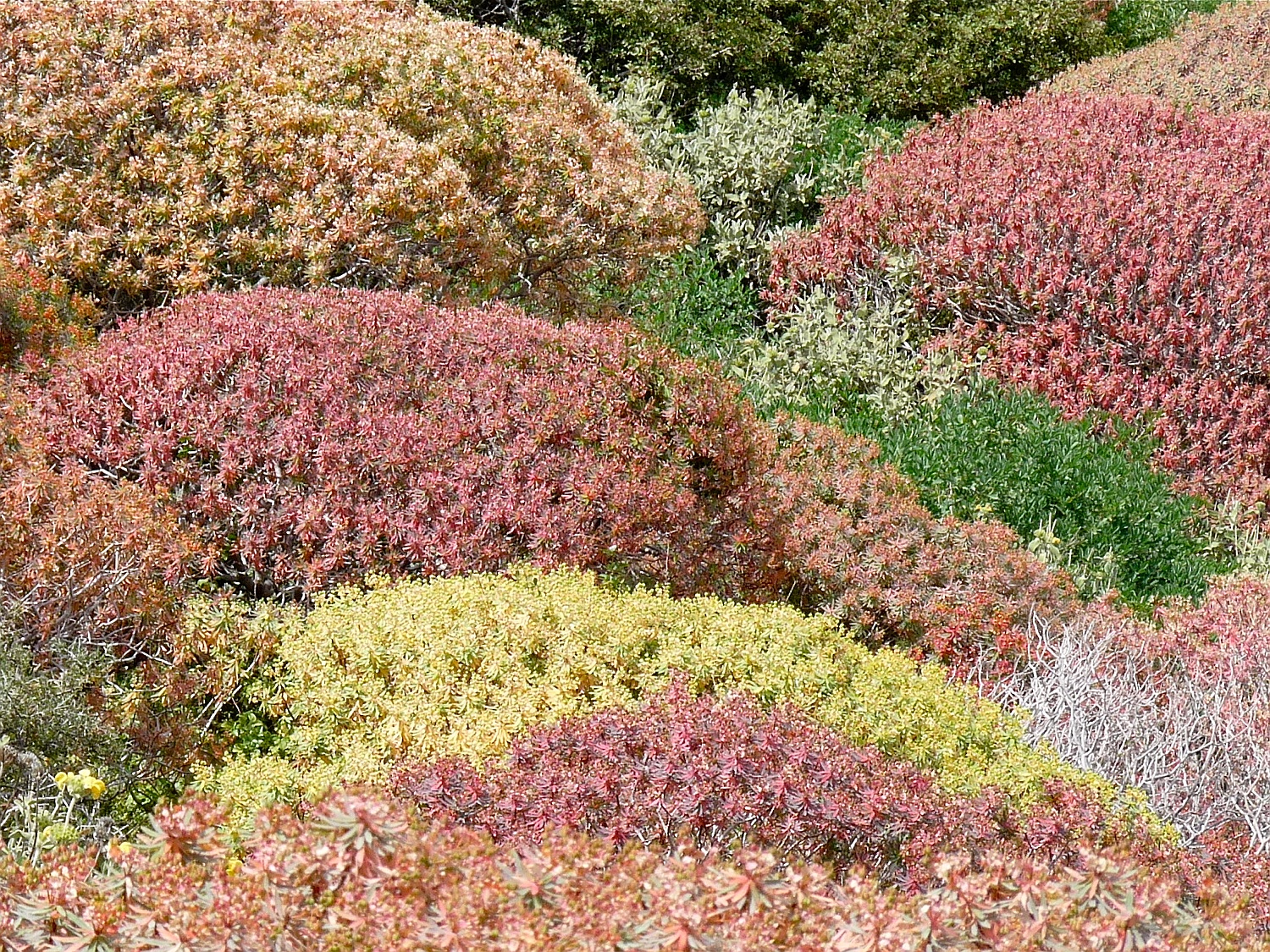
tree spurge near Apóllonas
The East and the South part of Naxos
The eastern and southern parts of the island have a particularly Mediterranean character. The subsoil here consists mainly of marble. The landscape is very dry, as most of the rainwater drains into the underground. The river valleys, where water only flows after heavy rainfalls, are densely covered with oleander, blooming intensely pink in early summer. Only in a few places is there enough water available for cultivation, but often the slopes and valleys are planted with olive groves.

river near Ágios Dimítris
The hills are mainly used as grazing land for goats and sheep. Old stone walls run across the mountains, separating the different properties. Due to the heavy grazing, most of the slopes are only sparsely grown, mostly with prickly dwarf shrubs or poisonous plants such as the sea squill, which sprouts tall white flowers in late summer. In many places, however, grow low forests of maquis of small trees more or less browsed by the goats, especially kermes oak, wild olive and Phoenician juniper, joined in the warmest areas near the sea by the carob tree, and at higher altitudes, by species which are not so draught-resistant, such as the Cretan maple.

landscape near Ágios Dimítris
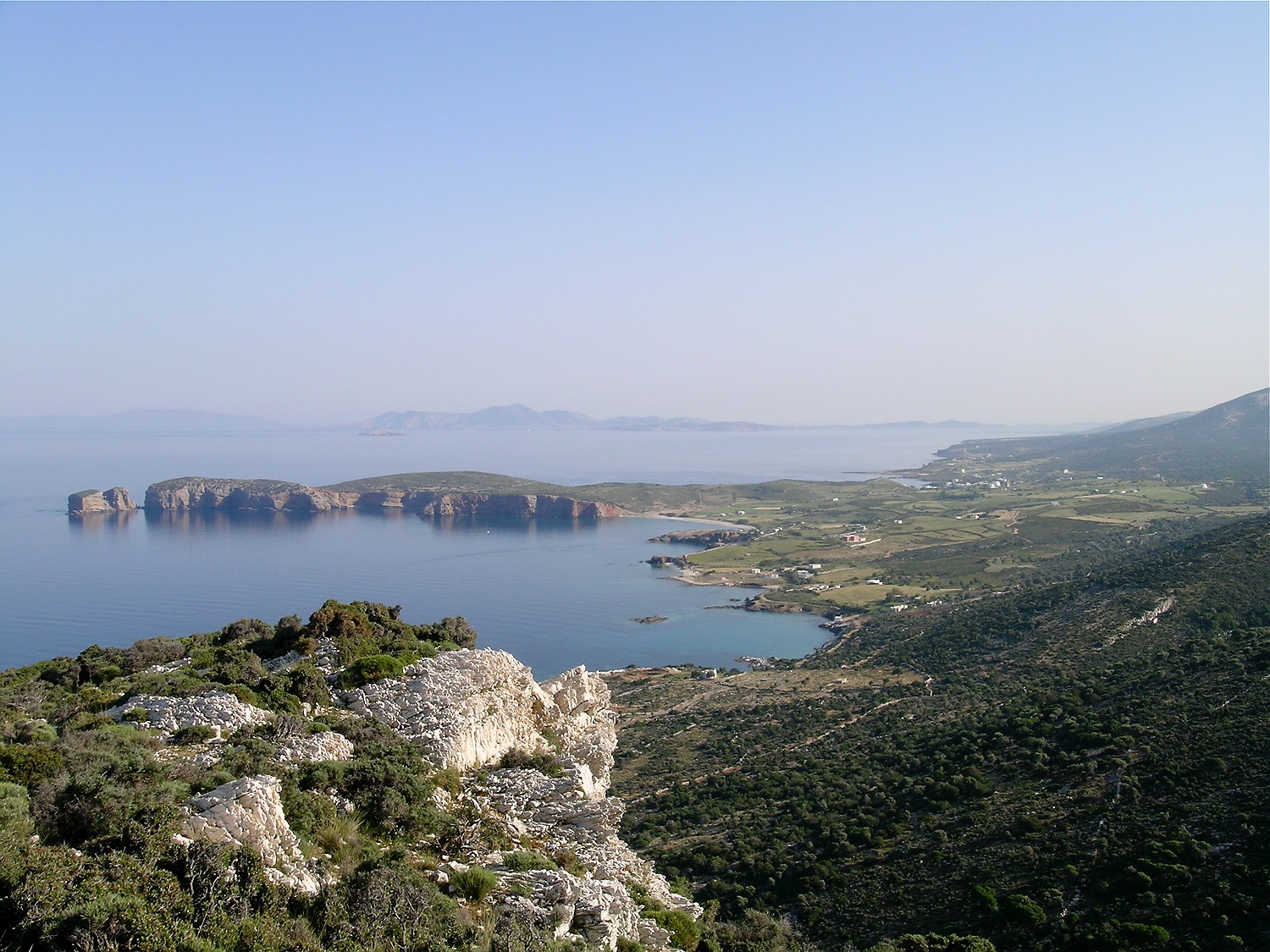
the East coast in winter
see also: The Mediterranean landscape
Comments are closed.